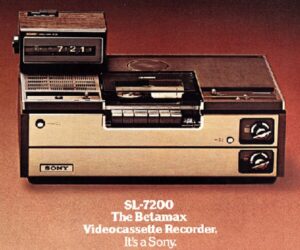 “The VCR is to the American film producer and the American public as the Boston Strangler is to the woman home alone.”
“The VCR is to the American film producer and the American public as the Boston Strangler is to the woman home alone.”
The quote above comes from the late Jack Valenti, who was the Motion Picture Association’s boss in 1982, when he warned the House of Representatives of the looming video recorder threat.
With the benefit of hindsight, the VCR wasn’t all that scary for Hollywood. The movie industry continued to flourish in the decades that followed, while technology continued along the path of progress too. New inventions have come along and for many rightsholders, generative AI (GenAI) is today’s growing concern.
The VCR threat cemented itself in legal history through the Betamax decision which still plays a role today, for various reasons. As reported yesterday, the decision was cited in the ongoing legal battle between book publishers and the Internet Archive. Simultaneously, the VCR is also starring in a legal dispute between the New York Times and Microsoft.
NYT vs. OpenAI/Microsoft
Late last year The Times sued OpenAI and Microsoft, alleging that its generative AI models were trained on copyrighted news articles. The news publication also suggested that, when prompted the right way, ChatGPT could recite content from these articles.
OpenAI previously asked the court to dismiss these claims, alleging that the New York Times ‘hacked’ its service to produce the ‘highly anomalous’ outputs. The Times’ DMCA violation claim, misappropriation claim, and contributory infringement claim either fail or fall short, OpenAI added.
Microsoft filed a separate motion to dismiss. Instead of focusing on alleged hacking practices, the company led with Jack Valenti’s ‘Boston Strangler’ analogy, part of an all-out effort by television and movie producers to stop a groundbreaking new technology.
Hollywood was ultimately unable to stop the VCR. The ‘scaremongering’ didn’t convince the Supreme Court in ‘Sony (Betamax) v. Universal City Studios’ and the VCR was declared legal. The rest is history.
Microsoft Cites VCR Scaremongering
According to Microsoft, the legal crusade against AI models should be seen similarly. Instead of alleging concrete copyright infringement by end users, the technology itself is framed as copyright-infringing. That’s incorrect, the tech giant countered in its motion to dismiss earlier this month.
“At most, The Times’s allegations establish Microsoft’s awareness that someone could use a GPT-based product to infringe. Of course, the same was true of the VCR — as it is of word processors, hard drives, social media feeds, internet connections, and so forth.
“Fortunately, the Supreme Court long ago rejected liability merely based on offering a multi-use product,” Microsoft added.
Microsoft asked the court to dismiss several key claims, including contributory copyright infringement. The claim fails because there’s no evidence that the tech company knew of any third-party copyright infringements or contributed to them, Microsoft argued.
NYT: AI is Nothing Like the VCR
Yesterday, The Times responded to the motion to dismiss, starting with a VCR analogy. According to the news outlet, the VCR is nothing like the GenAI threat they’re facing today.
“Defendants’ generative AI models are nothing like VCRs. Sony didn’t copy movies and television shows to build VCRs; Defendants built their AI models by copying millions of Times articles and other copyrighted works without permission or payment.”
Unlike the VCR, GPT services are trained on copyrighted content without permission and can reproduce these in part, The Times argues.
“Defendants are using their AI models to copy and summarize even breaking news articles that users would otherwise seek on a publisher’s website. If VCRs had been built with movies to make movies that compete with movies, or if Sony oversaw the VCR’s infringing users, Sony would have gone the other way.”
Microsoft’s defense is largely predicated on its conclusion that the use of copyrighted content for AI training is fair use. The Times sees this as an “absurd argument” but doesn’t respond to it in detail. Instead, it mostly sticks to its original claims.
‘Using AI to Bypass Paywalls’
One of the key claims in the complaint is contributory copyright infringement. According to legal precedents, a party can be found liable for copyright infringement if it induces, causes, or materially contributes to it. This is particularly true when a service has few non-infringing uses.
This claim was also used against Sony’s VCR but that ultimately failed. The Times hasn’t listed any concrete infringements in its complaint but notes that its pleadings against Microsoft are sufficient to survive a motion to dismiss at this stage.
“Although Microsoft argues that copyright infringement by users of its GenAI products is just a ‘theoretical possibility’, the question at this stage is whether The Times has plausibly alleged that such infringement has taken place. The answer is yes,” Microsoft notes.
To illustrate, The Times references a Gizmodo article that suggested ChatGPT’s ‘Browse with Bing’ was paused after people used it to bypass paywalls. Microsoft wasn’t blind to these copyright infringement issues, The Times notes, stressing that it previously alerted the company to its concerns.
All in all, the Times wants the case to move forward in its entirety while Microsoft would like it to end here. It’s now up to the court to decide if the case can go forward, and on what claims. Alternatively, the parties can choose to settle their disagreements outside of court but, thus far, there’s no evidence to show either side prefers that option.
—-
A copy of Microsoft’s motion to dismiss, submitted at a New York federal court, can be found here (pdf) and The Times’ response is available here (pdf)





